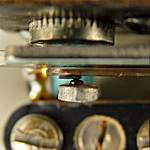
Western Electric Products - Technical - Ringers
Sewing Machine - Automatic Answering Service “Mirrophone” wire ribbon recorder/player Telephones - PicturePhone - Bell Chime
If you’ve ever heard the sound of an old mechanical telephone bell that was used in the telephones prior to the Bell System divestiture, you probably remember how loud they could be compared to today’s telephones with those wimpy, sissy, lame, bird-chirping electronic “ringers”. Those brass bells sure got your attention when they rang!
On this page we will be presenting various bells made before the days of the “poor-excuse-for-a-bell” piezoelectric trash we are forced to buy today. I’ve included some high-resolution digital photos of bell assemblies and their components.

We Offer Personalized One-On-One Service!
Call Us Today at (651) 787-DIAL (3425)


P-Type Ringer Information
The “P” type ringer consists of one steel or brass gong, a lever-position loudness control, a bias spring for adjusting bell sensitivity, a permanent magnet, an electromagnet, a brass clapper ball and iron core for concentrating the magnetic fields. It was designed to be much more compact than the “C” type ringer for use in the model 2554 wall phone, Princess phone and Trimline phone among others.
The following (slightly edited) was contributed by Rodger Hart, a visitor to this website:
“The Western Electric P-Type ringers were supplied with a brass gong (Western Electric Part #63-A) early on. They have the same general configuration as the steel gong (Part #WE-65-A).
There was also a muted version of the 63-A gong with muting “indentations” stamped into the gong rim in 3 places. (Part #WE-65-B)
Strangely enough, I like the “crisper” ring the 63-A (brass) gong produces over the sound of the 65-A (steel) gong.
I’m proud to say I also have a Western Electric Exeter telephone {1976 model} in brown; (An early version with a cast chromed trim band/internal component mount in tone dial) that I have added a Western Electric P1A ringer WITH the 63-A gong to. (It is still working quite well.)
Also, I believe the 63-A and 63-B gongs came primarily on early P-Type ringers with 5-wire “coil assemblies”.”
Identification and Maintenance
Maintenance and Ringer Adapter Plates
Schematic and Bias Spring positioning
Closeup of Bias Spring positioning
Table A andBias Spring Position
P-type ringer
The “P” type ringer has only one gong and was used in the model 2554 wall phone, Princess phone and Trimline phone among others.
Dissection of a P3A type Western Electric ringer:
-
Top view before dissecting
-
Bottom view before dissecting
-
**Gong removed
-
Bias spring settings - High bias setting - Low bias setting
-
Coil assembly, armature, magnet on base plate, misc. pieces..
-
Start of coil removal from field poles
-
Iron core laminations removed from center of coil (17 laminations)
C-Type Ringer Information
The “C” type ringer consists of two brass gongs, a stepped-cam loudness control, a bias spring for adjusting bell sensitivity, a permanent magnet, an electromagnet, a brass clapper ball and iron core for concentrating the magnetic fields. It was used in the model 500 and 2500 standard desk telephones and the 554 wall telephone among others.
General Information and MaintenanceVolume Control, Bias** **Spring Position, and InspectionGong types (distinctive** **tones)Table A - Bias Spring PositionTable B - Ringer Tests and Requirements
Below are links to the digital photographs of various parts of the C ringer assembly to help you identify the various parts of the ringer and functions/adjustment:
Strong bias (high notch) position - Use this position if you have “bell-tap” problems. “Bell-tap” is when a voltage spike on the phone line causes the bell clapper ball to hit one of the bells causing a quick “ding” sound. Voltage spikes can be from nearby lightening strikes, a rotary dial phone on the same line that is dialing a number, or going on or off hook.
Weak bias (low notch) position - Use this position if you have a lot of phones hooked up to your phone line. The added loads of many phones weakens the ringer current from the central office so by setting it on the low or weak position, it takes less energy from the central office to make the bell ring.
#7 SERIES WESTERN ELECTRIC RINGERS**
#7 bells and buzzers are all low voltage AC or DC devices. The voltages are listed in many WECo catalogs. According to catalog 12T for buzzers:
7A = 270 ohms, 14-40V DC, 15-21V AC
7B = 10.5 ohms, 2-6V DC, 4-9V AC
7C = 2.6 ohms, 2-8V DC, 3-8V AC
7D = 15.8 ohms, 4-15 V AC/DC
7E = 105 ohms, 10-20V AC/DC
7F = 682 ohms, 20-60V AC/DC
7A and 7E were typically used in key telephones systems @ 18VAC.
7C was typically used in early 1A key telephone systems without lamps where the only source of power for ICM talking and signaling was (3) #6 dry cells (total 4.5 Volts).
7F is commonly used as an alarm bell in 48VDC PBX equipment.
Note: The above descriptions were provided by Steph Kerman.**
7E Bell
Here are some photos of a new-old-stock (NOS) Western Electric 7E bell (or ringer) that I bought on eBay:
Front view of bell
Rear view of bell
Scale showing height of bell in centimeters
Scale showing width of bell in inches
Scale showing depth of bell in inches
Scale showing height of bell in inches (5.5")
Protective cover removed to show electromagnets, contacts, armature, striker arm and screw terminals.
Close-up view of contacts that open and close when bell is operating hence interrupting the current flow.
Click on images below for larger view
BSP sections on ringers:
E1-Type Ringers
F1A-Type Ringers - GIF format or PDF format
I1A-Type Ringers
S1A and S1AM Tone Ringer
W1A Tone Ringer
28A Ringer Isolator
603A Ringing Extender



Reliable, secure high-speed internet
With CenturyLink Simply Unlimited Internet, you can choose from a wide range of available speeds that fit your online needs. Plus, you can connect several devices with super-fast in-home WiFi.
Order Now









